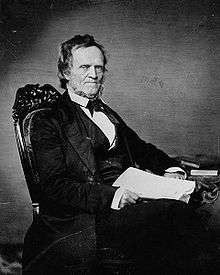Lower Canada
The Province of Lower Canada (French: province du Bas-Canada) was a British colony on the lower Saint Lawrence River and the shores of the Gulf of Saint Lawrence (1791–1841). It covered the southern portion of the current Province of Quebec and the Labrador region of the current Province of Newfoundland and Labrador (until the Labrador region was transferred to Newfoundland in 1809).[2]
Province of Lower Canada | |||||||||||
|---|---|---|---|---|---|---|---|---|---|---|---|
| 1791–1841 | |||||||||||
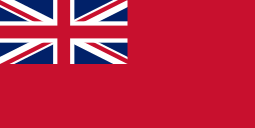 Civil ensign (1801 onward) | |||||||||||
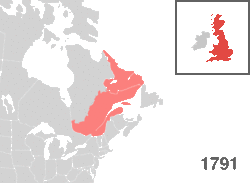 | |||||||||||
| Status | British colony | ||||||||||
| Capital | Quebec City | ||||||||||
| Common languages | French, English | ||||||||||
| Government | Château Clique oligarchy under a Constitutional monarchy | ||||||||||
| Sovereign | |||||||||||
• 1791–1820 | George III | ||||||||||
• 1820–1830 | George IV | ||||||||||
• 1830–1837 | William IV | ||||||||||
• 1837–1841 | Victoria | ||||||||||
| Lieutenant-Governor and Executive Council of Lower Canada | |||||||||||
| Legislature | Parliament of Lower Canada | ||||||||||
| Legislative Council | |||||||||||
| Legislative Assembly | |||||||||||
| Historical era | British Era | ||||||||||
• Constitutional Act of 1791 | 26 December 1791 | ||||||||||
| 10 February 1841 | |||||||||||
| Area | |||||||||||
| 1839[1] | 534,185 km2 (206,250 sq mi) | ||||||||||
| Population | |||||||||||
• 1839[1] | c. 700,000 | ||||||||||
| Currency | Canadian pound | ||||||||||
| |||||||||||
| Today part of | |||||||||||
Lower Canada consisted of part of the former colony of Canada of New France, conquered by Great Britain in the Seven Years' War ending in 1763 (also called the French and Indian War in the United States). Other parts of New France conquered by Britain became the Colonies of Nova Scotia, New Brunswick, and Prince Edward Island.
The Province of Lower Canada was created by the Constitutional Act 1791 from the partition of the British colony of the Province of Quebec (1763–1791)[3] into the Province of Lower Canada and the Province of Upper Canada. The prefix "lower" in its name refers to its geographic position farther downriver from the headwaters of the St. Lawrence River than its contemporary Upper Canada, present-day southern Ontario.
Lower Canada was abolished in 1841 when it and adjacent Upper Canada were united into the Province of Canada.[4]
Rebellion
Like Upper Canada, there was significant political unrest. Twenty-two years after the invasion by the Americans in the War of 1812, a rebellion now challenged the British rule of the predominantly French population. After the Patriote Rebellion in the Rebellions of 1837–1838[5] were crushed by the British Army and Loyal volunteers, the 1791 Constitution was suspended on 27 March 1838 and a special council was appointed to administer the colony. An abortive attempt by revolutionary Robert Nelson to declare a Republic of Lower Canada was quickly thwarted.
The provinces of Lower Canada and Upper Canada were combined as the United Province of Canada in 1841, when the Act of Union 1840 came into force. Their separate legislatures were combined into a single parliament with equal representation for both constituent parts, even though Lower Canada had a greater population.[6]
Constitution
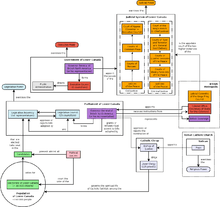
The Province of Lower Canada inherited the mixed set of French and English institutions that existed in the Province of Quebec during the 1763–1791 period and which continued to exist later in Canada-East (1841–1867) and ultimately in the current Province of Quebec (since 1867).
Population
Lower Canada was populated mainly by Canadiens, an ethnic group who trace their ancestry to French colonists who settled in Canada from the 17th century onward.
| Year | Census estimate[9] |
|---|---|
| 1806 | 250,000 |
| 1814 | 335,000 |
| 1822 | 427,465 |
| 1825 | 479,288 |
| 1827 | 473,475 |
| 1831 | 553,134 |
| 1841 | 650,000 |
Transportation
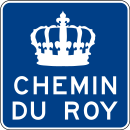
Travelling around Lower Canada was mainly by water along the St. Lawrence River. On land the only long-distance route was the Chemin du Roy or King's Highway, built in the 1730s by New France.[10] The King's Highway was, in addition to the mail route, the primary means of long-distance passenger travel until steamboats (1815) and railways (1850s) began to challenge the royal road.[10] The royal road's importance waned after the 1850s and would not re-emerge as a key means of transportation until the modern highway system of Quebec was created in the 20th century.
See also
- Canada East, period after the Act of Union 1840
- Former colonies and territories in Canada
- French and Indian War
- French and Indian Wars
- French colonial empire
- List of lieutenant governors of Quebec
- National Patriots' Day
- Ottawa River timber trade
- Province of Quebec (1763–1791)
- Rebellion
- Republic of Lower Canada
- The Canadas
- Timeline of Quebec history
- Upper Canada
References
- "The emigrant's handbook of facts concerning Canada, New Zealand, Australia, Cape of Good Hope, &c". Open Library. pp. 2–3. Retrieved 22 December 2013.
- "Labrador–Canada Boundary". marianopolis. 2007. Retrieved 20 March 2008.
Labrador Act, 1809. – An imperial act (49 Geo. III, cap. 27), 1809, provided for the re-annexation to Newfoundland of 'such parts of the coast of Labrador from the River St John to Hudson's Streights, and the said Island of Anticosti, and all other smaller islands so annexed to the Government of Newfoundland by the said Proclamation of the seventh day of October one thousand seven hundred and sixty-three (except the said Islands of Madelaine) shall be separated from the said Government of Lower Canada, and be again re-annexed to the Government of Newfoundland.'
- Fernand Ouellet (4 March 2015). "Lower Canada". The Canadian Encyclopedia. Historica Canada. Retrieved 18 August 2019.
- James Maurice Stockford Careless; Richard Foot (4 March 2015). "Province of Canada 1841–1867". The Canadian Encyclopedia. Historica Canada. Retrieved 18 August 2019.
- David Mills; Richard Foot (20 March 2017). "Durham Report". The Canadian Encyclopedia. Historica Canada. Retrieved 18 August 2019.
- Jacques Monet, SJ; Richard Foot (4 March 2015). "Act of Union". The Canadian Encyclopedia. Historica Canada. Retrieved 18 August 2019.
- "Mackenzie, William Lyon - Répertoire du patrimoine culturel du Québec". www.patrimoine-culturel.gouv.qc.ca. Retrieved 19 November 2018.
- "Louis-Joseph Papineau". The Canadian Encyclopedia. Historica Canada. Retrieved 18 August 2019.
- Censuses of Canada. 1665 to 1871, Statistics of Canada, Volume IV, Ottawa, 1876
- "History - Le Chemin du Roy". Le Chemin du Roy. Retrieved 19 November 2018.
summary of the original french version
Further reading
- Robert Christie. A History of the Late Province of Lower Canada, Quebec City: T. Cary/R. Montreal: Worthington, 1848–1855 (Internet Archive: All 6 volumes)
- François-Xavier Garneau. History of Canada : from the time of its discovery till the union year, Montreal : J. Lovell, 1860 (Internet Archive: All 3 Volumes)
External links


- "Lower Canada". The Canadian Encyclopedia.
- Lower Canada - Encyclopædia Britannica
- Gouvernors of Lower Canada - Histoire du Québec(in French)
- Lower Canada - Library and Archives Canada
- Lower Canada - Quebec Parliament library(in French)
